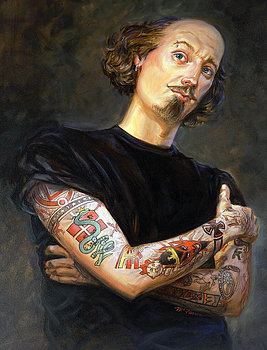On Friday, May 27th I worked for a few hours then drove to Amherst, Massachusetts to visit the Mead Museum at Amherst College to see one of William Shakespeare’s First Folio’s. The Folger Shakespeare Library is celebrating “The Wonder of Will – 400 Years of Shakespeare” by bringing a First Folio to each of the fifty states plus Puerto Rico and, of course, Washington D.C. This was the last weekend to see the Mead exhibit, and since I was heading to New Hampshire with my son on Saturday morning, I made the windy drive out to the Pioneer Valley.
After parking the car at the town square, I followed Boltwood Avenue to College Street then crossed over to the Amherst College campus. My anticipation at seeing The Book that gave us literature’s most celebrated playwright dictated the speed of my walk and quickness of breath, which after entering the museum and bringing myself to a calm, was re-imagined as I pulled tight the reigns of my eagerness; I gathered my self together, and walked through the first gallery observing each art work before stepping into the Shakespearean exhibit space. If you have not visited the Mead, it is a worthwhile trip to see Rockwell Kent’s Clover Fields (1939-1940) among a beautifully curated salon wall, and across from that is, perhaps one of my favorites in their permanent collection, Paolo and Francesca (1856) by Dutch artist Ary Scheffer; the lovers’ bodies are exquisitely enraptured against the contrasting darkness of fate. Francesca’s hold on Paolo is delicate yet anchored to their shared ecstasy, separated by a fabric swath. Seeing Dante’s adulterous lovers before seeing Hamlet and Ophelia share pages in the Folio was Fortune’s gift.

“Tattooed Shakespeare” by Mathew McFarren. Click on title for purchasing information. Original is sold.
The “Wonder of Will” exhibit included several panels of factual information about Shakespeare himself, the language, actors, history and so forth. Also included was Louise Bourgeois’s lithograph Hamlet and Ophelia (1996-1997) (admittedly not one of my favorite pieces of hers, but I can appreciate the curator’s decision for including it) and Ophelia (1875) by Thomas Francis Dicksee. The First Folio was encased in a glass box open to Hamlet’s famous “To be or Not to be” speech. I made every attempt to read fully the double-sided leaves, bright white, nearly translucent–you could see the font come through on the next page, which only created a temptation to turn pages if that were possible. The Shakespeare line that impressed me to most is Hamlet’s spiteful, “Get thee to a nunnerie!” while looking straight across the wall behind the Folio which displays Dicksee’s Ophelia. Engaging in the experience of reading and looking, intermittently observing two works of art containing the breadth of complex ardor and madness is a breathless maneuver; with all my own dramatic emotion, I am lucky to remain standing.
If you have an opportunity to see a First Folio I encourage you to search out a location near you. It is possible you might have to wait in line to see it, and your viewing may possibly be timed depending on the crowd. I was lucky; there were other museum visitors, and although I was bewitched by selfishness, I returned to the podium three or four times to soak up as much history as possible. Hopefully in the near future I can visit the Folger Shakespeare Library in Washington D.C. If you already have, do not speak of it–“So full of artless jealousy is guilt”